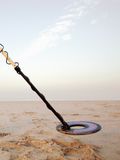Science
Discovering the Science Behind Metal Detectors: How They Work

Metal detectors have become essential tools for treasure hunters, archaeologists, and hobbyists alike. They enable users to locate buried metallic objects without the need for extensive digging. But how exactly do these devices function? Understanding the underlying physics reveals their impressive capabilities.
The Science of Metals and Conductivity
Metals possess unique properties that differentiate them from non-metallic materials. All solid objects are made up of atoms, which consist of a positively charged nucleus surrounded by negatively charged electrons. In nonmetals like plastic or glass, the electrons remain largely bound to their respective atoms. In contrast, metals such as copper allow their outer electrons to move freely among the atoms. This characteristic is what enables metals to conduct electricity effectively.
To create an electric field, one common method is to apply a charge to a metal surface, as is done with batteries. However, in the case of metal detectors, a different approach is employed. According to Faraday’s law, a changing magnetic field generates an electric field. When a magnet is brought near a metal conductor, the movement generates a changing magnetic field, which induces an electric field and produces what are known as eddy currents in the metal.
The Mechanism of Detection
The interaction between these eddy currents and the original magnetic field is the cornerstone of metal detection. A simple demonstration involves placing a magnet above a coin and quickly lifting it. This action creates eddy currents within the coin, resulting in a magnetic field that interacts with the magnet. Interestingly, the extent of this effect varies based on the metal’s composition. For example, a 1959 quarter, primarily made of silver, exhibits a stronger response than a modern quarter composed of a copper alloy due to silver’s lower electrical resistance.
While this method illustrates the basic workings of a metal detector, it is impractical for regular use. To enhance functionality, most metal detectors utilize a more sophisticated design, incorporating coils of wire. When an alternating electric current flows through the coil, it generates a changing magnetic field in an iron core. This field then induces a secondary electric current in a nearby metal object, which in turn creates its own magnetic field. When a metal is detected, the interaction between the two magnetic fields triggers a signal.
To further refine detection, many devices employ a dual-coil system—an emitter coil and a receiver coil. By positioning these coils to negate each other’s magnetic fields, the device can accurately identify when a metal object disrupts this balance, leading to detection.
Utilizing Resonance for Enhanced Detection
Another innovative technique in metal detection involves resonance. This principle can be illustrated by the action of pushing a swing: if the push matches the swing’s natural frequency, the amplitude of its motion increases. Similarly, metal detectors can utilize resonance through an oscillating circuit that includes an inductor and a capacitor. When the detector is held over a buried metal object, the oscillation frequency changes, signaling a successful detection.
The allure of metal detecting is not merely in the technology but also in the potential rewards. For instance, a 13th-century gold coin unearthed in England sold for an astonishing $850,000. However, many users often find mundane items, such as pull tabs from soda cans, during their searches. Despite this, the excitement lies in the journey of discovery and the understanding of how these remarkable devices operate.
In summary, metal detectors capitalize on the interplay of electric and magnetic fields, allowing users to locate metallic objects buried beneath the surface. By harnessing scientific principles, these devices transform the seemingly mundane act of searching for lost items into a thrilling adventure in treasure hunting.
-

 Technology5 months ago
Technology5 months agoDiscover the Top 10 Calorie Counting Apps of 2025
-

 Technology3 weeks ago
Technology3 weeks agoOpenAI to Implement Age Verification for ChatGPT by December 2025
-

 Health3 months ago
Health3 months agoBella Hadid Shares Health Update After Treatment for Lyme Disease
-

 Health3 months ago
Health3 months agoAnalysts Project Stronger Growth for Apple’s iPhone 17 Lineup
-

 Health3 months ago
Health3 months agoErin Bates Shares Recovery Update Following Sepsis Complications
-

 Technology5 months ago
Technology5 months agoDiscover How to Reverse Image Search Using ChatGPT Effortlessly
-

 Technology3 months ago
Technology3 months agoElectric Moto Influencer Surronster Arrested in Tijuana
-

 Technology2 months ago
Technology2 months agoDiscover 2025’s Top GPUs for Exceptional 4K Gaming Performance
-

 Technology5 months ago
Technology5 months agoMeta Initiates $60B AI Data Center Expansion, Starting in Ohio
-

 Technology5 months ago
Technology5 months agoRecovering a Suspended TikTok Account: A Step-by-Step Guide
-

 Health5 months ago
Health5 months agoTested: Rab Firewall Mountain Jacket Survives Harsh Conditions
-

 Lifestyle5 months ago
Lifestyle5 months agoBelton Family Reunites After Daughter Survives Hill Country Floods





















